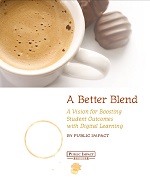 A Vision for Boosting Student Outcomes with Digital Learning
A Vision for Boosting Student Outcomes with Digital Learning
“Technology alone isn’t going to improve student achievement. The best combination is great teachers working with technology to engage students in the pursuit of the learning they need.”
— U.S. Secretary of Education Arne Duncan
Blended learning that combines digital instruction with live, accountable teachers holds unique promise to improve student outcomes dramatically. This brief explains how schools can use blended learning to encourage improvements in digital instruction, transform teaching into a highly paid, opportunity-rich career that extends the reach of excellent teachers to all students and teaching peers, and improve student learning at large scale. We call this a “better blend”: combining high-quality digital learning and excellent teaching.
The potential of blended learning to improve student achievement arises from two benefits of blended models that build on each other. One is the power of digital instruction to personalize learning. The other is the capacity of blended models to let schools reach more students with excellent teachers who ensure that students achieve ambitious, personally fulfilling goals.
For a better blend of technology and teachers, schools must find and use the best available digital tools while also dramatically increasing students’ access to excellent teachers through:
- Selectivity: Hiring selectively based on indicators predictive of outstanding teaching
- Reach: Extending the reach of excellent teachers to more students, directly and through team leadership
- Freed time: Scheduling to give teachers time to collaborate, develop, and analyze student learning data during school hours
- Accountability: Giving excellent teachers credit and accountability for the growth of all students under their purview, including those taught by the teachers on teams that they lead
- Authority: Vesting excellent teachers with control of the digital content they use
- Rewards: Investing savings in paying teachers far more for achieving excellence with more students, making stronger recruitment and enhanced selectivity possible.
Then, to achieve excellent learning at scale, state policymakers must change state policy to enable and incentivize a better blend in large numbers of schools, through:
- Funding that is flexible and weighted by student need, so that schools may invest in the people and technology that best advance their students’ learning
- People policies that let schools hire, develop, deploy, pay, advance, and retain excellent teachers and collaborative teaching teams to reach every student with excellent teachers
- Accountability, using increasingly better measures, that drives teaching and technology excellence and improvement, so that excellent teachers and their teams get credit for using blended learning to help more students
- Technology and student data that are available for all students, allowing differentiated instruction for all students without regard to their economic circumstances
- Timing and scalability, including implementing a better blend from the start in new and turnaround-attempt schools — when schools often have more freedoms to implement new staffing models.
Digital learning may be life-changing for students and career-boosting for teachers, but only if schools and policymakers commit to a better blend.
